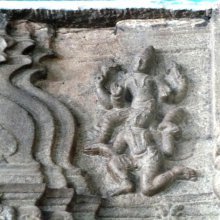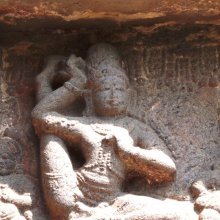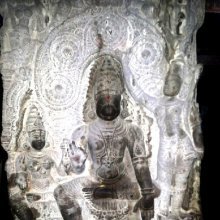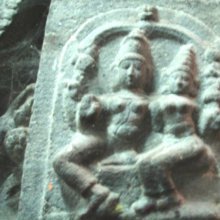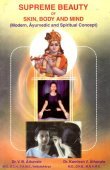Sitting: 2 definitions
Introduction:
Sitting means something in Buddhism, Pali, Hinduism, Sanskrit. If you want to know the exact meaning, history, etymology or English translation of this term then check out the descriptions on this page. Add your comment or reference to a book if you want to contribute to this summary article.
Images (photo gallery)
(+64 more images available)
In Hinduism
Natyashastra (theatrics and dramaturgy)
Source: Shodhganga: Elements of Art and Architecture in the Trtiyakhanda of the Visnudharmottarapurana (natya)Sitting (in chariot or aeroplanes) is associated with Samapāda: one of the “six kinds of Standing Postures for Men” (in Indian Dramas), according to the Viṣṇudharmottarapurāṇa, an ancient Sanskrit text which (being encyclopedic in nature) deals with a variety of cultural topics such as arts, architecture, music, grammar and astronomy.—Standing postures are determined separately for male and female. In the Viṣṇudharmottarapurāṇa six kinds of standing postures are discussed for men. The word sama denotes the equal position. In samapāda position, both the legs are placed at a distance of one tāla. This posture is seen in the auspicious performance of Brahmins. This posture is also used to denote jumping of birds and sitting in chariot or aeroplanes.

Natyashastra (नाट्यशास्त्र, nāṭyaśāstra) refers to both the ancient Indian tradition (shastra) of performing arts, (natya—theatrics, drama, dance, music), as well as the name of a Sanskrit work dealing with these subjects. It also teaches the rules for composing Dramatic plays (nataka), construction and performance of Theater, and Poetic works (kavya).
In Buddhism
General definition (in Buddhism)
Source: A Buddhist Library: In This Very LifeSitting refers to one of the Traditional Four Postures (used in any type of meditation).—Suitable and appropriate activities can bring about insight knowledge. Seven types of suitability should be met in order to create an environment that is supportive of meditation practice. [...] The seventh and last kind of suitability is that of posture. Sitting is best for samatha or tranquillity meditation. In the tradition of Mahasi Sayadaw, vipassana practice is based on sitting and walking.
See also (Relevant definitions)
Starts with: Sitting Position, Sitting posture.
Full-text (+1235): Asana, Upavishta, Virasana, Upavesha, Asina, Nishanna, Sahasana, Baithaka, Avashakthika, Nivishta, Yanasana, Paryanka, Abhishravana, Nisadana, Samasina, Baithak, Purvasad, Nishatti, Asadana, Jamakhana.
Relevant text
Search found 418 books and stories containing Sitting; (plurals include: Sittings). You can also click to the full overview containing English textual excerpts. Below are direct links for the most relevant articles:
A Few Types of Assamese Folk-Songs < [December 1947]
If You Have... < [July – September, 1981]
'The Triple Stream' < [November 1937]
Concept of Oneness in the Upanishads (study) (by Chandra Shekhar Upadhyaya)
Upaniṣad: A Brief Introduction < [Chapter 1 - Introduction]
Concept of Oneness in Mụṇḍaka Upaniṣad < [Chapter 5 - Concept of Oneness in Atharvavedic Upaniṣads]
Meaning of Oneness < [Chapter 1 - Introduction]
The Skanda Purana (by G. V. Tagare)
Chapter 28 - Eminence of sitting awake on the twelfth day in worship of Viṣṇu < [Section 4 - Dvārakā-māhātmya]
Chapter 27 - Desirability of sitting awake on the twelfth day to worship < [Section 4 - Dvārakā-māhātmya]
Chapter 26 - Worship of Hari on the twelfth day < [Section 4 - Dvārakā-māhātmya]
Vipassana Meditation Course (by Chanmyay Sayadaw)
Part 1 - Postures < [Chapter 8 - Daily Activities]
Part 2 - Noting Objects < [Chapter 8 - Daily Activities]
Part 3 - Sitting Meditation < [Vipassana Meditation Guidelines]
Practicing Insight on Your Own (by Acharn Thawee Baladhammo)
The Second Step < [Chapter 1]
Gauging The Results Of The Practice < [Chapter 6]
The Method Of Adjusting The 5 Indriya Evenly < [Chapter 4]
Vinaya Pitaka (1): Bhikkhu-vibhanga (the analysis of Monks’ rules) (by I. B. Horner)
Related products
